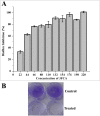covR Mediated Antibiofilm Activity of 3-Furancarboxaldehyde Increases the Virulence of Group A Streptococcus
- PMID: 25978065
- PMCID: PMC4433207
- DOI: 10.1371/journal.pone.0127210
covR Mediated Antibiofilm Activity of 3-Furancarboxaldehyde Increases the Virulence of Group A Streptococcus
Abstract
Background: Group A streptococcus (GAS, Streptococcus pyogenes), a multi-virulent, exclusive human pathogen responsible for various invasive and non-invasive diseases possesses biofilm forming phenomenon as one of its pathogenic armaments. Recently, antibiofilm agents have gained prime importance, since inhibiting the biofilm formation is expected to reduce development of antibiotic resistance and increase their susceptibility to the host immune cells.
Principal findings: The current study demonstrates the antibiofilm activity of 3Furancarboxaldehyde (3FCA), a floral honey derived compound, against GAS biofilm, which was divulged using crystal violet assay, light microscopy, and confocal laser scanning microscopy. The report is extended to study its effect on various aspects of GAS (morphology, virulence, aggregation) at its minimal biofilm inhibitory concentration (132μg/ml). 3FCA was found to alter the growth pattern of GAS in solid and liquid medium and increased the rate of auto-aggregation. Electron microscopy unveiled the increase in extra polymeric substances around cell. Gene expression studies showed down-regulation of covR gene, which is speculated to be the prime target for the antibiofilm activity. Increased hyaluronic acid production and down regulation of srtB gene is attributed to the enhanced rate of auto-aggregation. The virulence genes (srv, mga, luxS and hasA) were also found to be over expressed, which was manifested with the increased susceptibility of the model organism Caenorhabditis elegans to 3FCA treated GAS. The toxicity of 3FCA was ruled out with no adverse effect on C. elegans.
Significance: Though 3FCA possess antibiofilm activity against GAS, it was also found to increase the virulence of GAS. This study demonstrates that, covR mediated antibiofilm activity may increase the virulence of GAS. This also emphasizes the importance to analyse the acclimatization response and virulence of the pathogen in the presence of antibiofilm compounds prior to their clinical trials.
Conflict of interest statement
Figures








Similar articles
-
Fukugiside, a biflavonoid from Garcinia travancorica inhibits biofilm formation of Streptococcus pyogenes and its associated virulence factors.J Med Microbiol. 2018 Sep;67(9):1391-1401. doi: 10.1099/jmm.0.000799. Epub 2018 Jul 27. J Med Microbiol. 2018. PMID: 30052177
-
Eucalyptol inhibits biofilm formation of Streptococcus pyogenes and its mediated virulence factors.J Med Microbiol. 2020 Nov;69(11):1308-1318. doi: 10.1099/jmm.0.001253. J Med Microbiol. 2020. PMID: 32930658
-
5-Dodecanolide inhibits biofilm formation and virulence of Streptococcus pyogenes by suppressing core regulons of virulence.Life Sci. 2020 Dec 1;262:118554. doi: 10.1016/j.lfs.2020.118554. Epub 2020 Oct 6. Life Sci. 2020. PMID: 33035584
-
Streptococcus pyogenes biofilms-formation, biology, and clinical relevance.Front Cell Infect Microbiol. 2015 Feb 11;5:15. doi: 10.3389/fcimb.2015.00015. eCollection 2015. Front Cell Infect Microbiol. 2015. PMID: 25717441 Free PMC article. Review.
-
Cellular interactions of covR/S mutant group A Streptococci.Microbes Infect. 2018 Oct-Nov;20(9-10):531-535. doi: 10.1016/j.micinf.2017.12.009. Epub 2017 Dec 26. Microbes Infect. 2018. PMID: 29287985 Review.
Cited by
-
Streptococcus pyogenes Capsule Promotes Microcolony-Independent Biofilm Formation.J Bacteriol. 2019 Aug 22;201(18):e00052-19. doi: 10.1128/JB.00052-19. Print 2019 Sep 15. J Bacteriol. 2019. PMID: 31085695 Free PMC article.
-
Proteomic and Systematic Functional Profiling Unveils Citral Targeting Antibiotic Resistance, Antioxidant Defense, and Biofilm-Associated Two-Component Systems of Acinetobacter baumannii To Encumber Biofilm and Virulence Traits.mSystems. 2020 Nov 17;5(6):e00986-20. doi: 10.1128/mSystems.00986-20. mSystems. 2020. PMID: 33203690 Free PMC article.
-
Phytochemical characterization and evaluation of antioxidant, antimicrobial, antibiofilm and anticancer activities of ethyl acetate seed extract of Hydnocarpus laurifolia (Dennst) Sleummer.3 Biotech. 2022 Sep;12(9):215. doi: 10.1007/s13205-022-03267-3. Epub 2022 Aug 8. 3 Biotech. 2022. PMID: 35959166 Free PMC article.
-
Explication of the Potential of 2-Hydroxy-4-Methoxybenzaldehyde in Hampering Uropathogenic Proteus mirabilis Crystalline Biofilm and Virulence.Front Microbiol. 2019 Dec 10;10:2804. doi: 10.3389/fmicb.2019.02804. eCollection 2019. Front Microbiol. 2019. PMID: 31921010 Free PMC article.
-
The Anti-Biofilm Potential of Linalool, a Major Compound from Hedychium larsenii, against Streptococcus pyogenes and Its Toxicity Assessment in Danio rerio.Antibiotics (Basel). 2023 Mar 9;12(3):545. doi: 10.3390/antibiotics12030545. Antibiotics (Basel). 2023. PMID: 36978412 Free PMC article.
References
-
- Kim S, Lee NY (2004) Epidemiology and antibiotic resistance of group A streptococci isolated from healthy school children in Korea. J Antimicrob Chemoth 54: 447–450. - PubMed
Publication types
MeSH terms
Substances
LinkOut - more resources
Full Text Sources
Other Literature Sources

